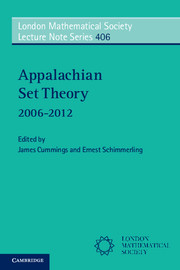Book contents
- Frontmatter
- Contents
- Contributors
- Introduction
- 1 An introduction to ℙmax forcing
- 2 Countable Borel equivalence relations
- 3 Set theory and operator algebras
- 4 A tutorial on Set Mapping Reflection
- 5 An introduction to hyperlinear and sofic groups
- 6 Aronszajn trees and the SCH
- 7 Iterated forcing and the Continuum Hypothesis
- 8 Short extender forcing
- 9 The complexity of classi?cation problems in ergodic theory
- 10 On the strengths and weaknesses of weak squares
- 11 Proper forcing remastered
- 12 Set theory and von Neumann algebras
- 13 The HOD Dichotomy
12 - Set theory and von Neumann algebras
Published online by Cambridge University Press: 05 December 2012
- Frontmatter
- Contents
- Contributors
- Introduction
- 1 An introduction to ℙmax forcing
- 2 Countable Borel equivalence relations
- 3 Set theory and operator algebras
- 4 A tutorial on Set Mapping Reflection
- 5 An introduction to hyperlinear and sofic groups
- 6 Aronszajn trees and the SCH
- 7 Iterated forcing and the Continuum Hypothesis
- 8 Short extender forcing
- 9 The complexity of classi?cation problems in ergodic theory
- 10 On the strengths and weaknesses of weak squares
- 11 Proper forcing remastered
- 12 Set theory and von Neumann algebras
- 13 The HOD Dichotomy
Summary
The fifteenth Appalachian Set Theory workshop was held at Carnegie Mellon University in Pittsburgh on March 3, 2012. The lecturer was Asger Törnquist. As a graduate student Martino Lupini assisted in writing this chapter, which is based on the workshop lectures.
Introduction
The aim of the lectures is to give a brief introduction to the area of von Neumann algebras to a typical set theorist. The ideal intended reader is a person in the field of (descriptive) set theory, who works with group actions and equivalence relations, and who is familiar with the rudiments of ergodic theory, and perhaps also orbit equivalence. This should not intimidate readers with a different background: Most notions we use in these notes will be defined. The reader is assumed to know a small amount of functional analysis. For those who feel a need to brush up on this, we recommend consulting [Ped89].
What is the motivation for giving these lectures, you ask. The answer is two-fold: On the one hand, there is a strong connection between (non-singular) group actions, countable Borel equivalence relations and von Neumann algebras, as we will see in Lecture 3 below. In the past decade, the knowledge about this connection has exploded, in large part due to the work of Sorin Popa and his many collaborators. Von Neumann algebraic techniques have lead to many discoveries that are also of significance for the actions and equivalence relations themselves, for instance, of new cocycle superrigidity theorems.
- Type
- Chapter
- Information
- Appalachian Set Theory2006–2012, pp. 363 - 396Publisher: Cambridge University PressPrint publication year: 2012

